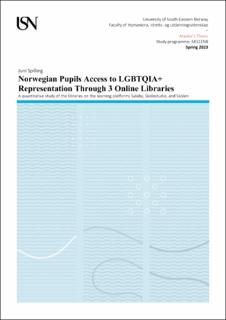Norwegian Pupils Access to LGBTQIA+ Representation Through 3 Online Libraries
Master thesis

Permanent lenke
https://hdl.handle.net/11250/3080536Utgivelsesdato
2023Metadata
Vis full innførselSamlinger
Sammendrag
This thesis examines the accessibility of LGBTQIA+ representative books primary school pupils have access to on the online learning platforms Salaby, SkoleStudio, and Skolen. The study was done by recording and presenting the English books in the designated libraries for years 1 – 10, as the pupils receive access to the libraries of years above and below them on the platforms. All pupils deserve to receive good and authentic LGBTQIA+ representation to positively affect their self-image, help develop their identity, and to give them good role models and depictions of LGBTQIA+ individuals' experiences.
The representation found in the books got categorized into explicit and implicit representation, where explicit representation is preferred to ensure the pupils are aware of the representation. After that, the books were analyzed thematically to identify different types of representation and which sexualities get depicted. The different types of representation highlighted in the study are authentic vs. sensationalized representation and the main character vs. supporting characters being representative. The thesis also discusses the perceived heteronormativity, queerbaiting, performativity, stereotypical projections, and bisexual erasure. Given LK20's requirements for pupils' ability to discuss their identity, different ways of living, and respect for others, discussing LGBTQIA+ representation in schools becomes crucial, along with assessing whether the learning objectives can be achieved.
The study's results showcased minimal LGBTQIA+ representation, wherein two (2) out of one hundred and eighty-nine (189) books contained LGBTQIA+ representation, Bi-Normal, and The Art of Being Normal. Both books contain authentic representation, where one book showcases the perspective of two transexual teenagers, and the other showcases the perspective of a Bisexual teenager. The books also contain characters who are explicitly homosexual, both gay men and one lesbian. However, no characters are expressed as queer/questioning, intersexual, asexual, or other sexualities outside of LGBT. Both books show heteronormative mindsets and victimization of LGBTQIA+ characters. There were also no books aimed towards the younger grades. Both books containing representation were aimed towards secondary school pupils. Additionally, the characters in both books might be too old for pupils in primary school age to relate to them, even if they have the necessary reading comprehension and abilities. This potentially leaves young pupils in Norway without proper access to LGBTQIA+ representation in books.